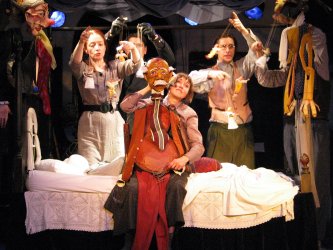
Paulanne Simmons
"The Bass Saxophone" Shines
 |
| "The Bass Saxophone" by Czechoslovak-American Marionette Theatre. L-R: Deborah Beshaw, Steven Ryan, Theresa Linnihan, Joseph Zuzel. |
"The Bass Saxophone"
Directed by Vit Horejs
Grand Army Plaza Memorial Arch
Center of Flatbush, Easter Parkway and Prospect Park West in Brooklyn
Fri. and Sat. 8 p.m., Sat. and Sun 3 p.m.
Free. Donations gratefully accepted
Reservations recommended: (212) 868-4444 or visit SmartTix.com
Opened Oct. 7, closes Oct. 30
Reviewed by Paulanne Simmons Oct. 2, 2005
Born in 1924 in Nachod, Bohemia, Czechoslovakia, Josef Skvorecky spent two years as a slave laborer in a German aircraft factory during WWII; saw his first novel, "The Cowards" (written in 1949, not published until 1958), condemned, banned and seized by the communist police; and fled to Canada with his wife, actress Zdena Salivarova, after the Soviet invasion of 1968. In 1971, Skvorecky and his wife founded Sixty-Eight Publishing Corp., and for over twenty years published banned Czech and Slovak books, for which Vaclav Havel, president of the post-Communist Czech Republic awarded them the Order of the White Lion.
To say the least, Skvorecky knows something about repression and personal freedom. This is most evident in his short story, "The Bass Saxophone," which Czech puppeteer Vit Horejs (with exclusive permission from the author) has adapted for his Czechoslovak-American Marionette Theatre. The play has been brilliantly staged outside, up the staircase and inside on the top floor of the Grand Army Plaza Memorial Arch in Brooklyn. The set designer is the capable and innovative Roman Hladik.
"The Bass Saxophone" is about a young Czech man, Danny (Joseph Zuzel), who is in love with jazz – the music banned by the Nazis in occupied Czechoslovakia. One day, Danny discovers a bass saxophone in front of a decrepit hotel and is persuaded to bring it into the hotel by its owner, a member of a German dance band.
The audience now follows Danny inside the arch, up the spiral staircase and past macabre tableaux created by puppets and live actors. In the top room of the arch, Danny meets the Wehrmacht musicians (four-foot paper mache puppets created by Theresa Linnihan, which are manipulated by and interact with the puppeteers). They jam with him on and around an ancient canopy bed.
Each of the musicians has his or her own story of lost love and personal sorrow. They are crippled and blind. They have grotesque faces and expressions that seem to have stepped out of a German Expressionist painting. Their stories are enhanced through eight-inch marionettes created by Prague designer Milos Kasal.
The music is a glorious combination of American swing, European popular music of the mid-twentieth century, and music written and improvised for the action by musical director John Hyde, who also plays the keyboard.
The Bass Saxophone, a tale of the liberating power of music, is told in the tradition of Czech puppet theater, influenced by Czech writer Franz Kafka reinterpreted through German Expressionist angst. The result is totally fascinating and original. [Simmons]

| museums | NYTW mail | recordings | coupons | publications | classified |